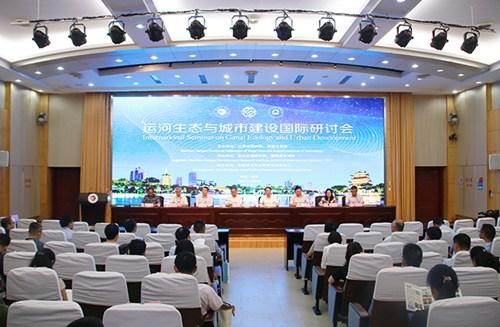
. > WHAT'S NEW > RESEARCH
Seminar explores Grand Canal ecology and urban development
Author : WANG GUANGLU Source : Chinese Social Sciences Today 2020-10-24

Photo: HYIT
The International Seminar on Canal Ecology and Urban Development was recently held at Huaiyin Institute of Technology in Jiangsu Province.
As the world's longest man-made waterway, stretching around 1,100 miles (though not all of it a canal), the Grand Canal was constructed in sections from the 5th century BCE onwards. In addition to being a "flowing" and "living" cultural belt, the Grand Canal is an ecological belt, economic belt, and urban belt.
The Grand Canal boasts a wealth of natural landscapes and historical and cultural heritage, connecting the economy, society, ideology, and culture of the region. With its great cultural value and tourism economic value, the construction of the Grand Canal cultural belt is able to meet the exchange needs at home and abroad, said Fabio Pollice, president of the University of Salento in Italy.
With a long history, the Grand Canal still has important modern values and practical significance, said Denis Lyapin, an associate professor at Yelets State University in Russia. Although air, railway, and road transport routes have increasingly been built, the Grand Canal still plays an important role in waterway transport, as it has a cargo transport capacity several times that of the same road mileage. In addition, the Grand Canal builds bridges between historical and present times for the people and cities along the canal.
For millions of years, human beings have successively experienced four stages of civilization: hunting-gathering civilization, agricultural civilization, industrial civilization, and ecological civilization. Urban issues are a top priority in the construction of an ecological civilization. The construction of livable cities, ecological cities, and beautiful cities necessarily involves water ecology. The Grand Canal is a water body that is closely related to urban development, said He Yun’ao, director and a professor from the Cultural and Natural Heritage Research Institute at Nanjing University.
Xia Jinwen, president of Jiangsu Provincial Academy of Social Sciences, said that the culture surrounding the Grand Canal can be a powerful tool for urban economic transformation. The integration of culture and tourism will fully excavate and display the unique charm of cities along the canal. The optimization of canal ecological environments will enhance the construction of livable cities. In-depth thinking, overall planning and systematic implementation are required in the course of utilizing the thousand-mile canal to drive cultural inheritance and urban development.
In terms of Jiangsu Province, the Grand Canal provides an effective approach to the construction of ecological civilization and a beautiful Jiangsu, which should be utilized to achieve the goal of building ecological cities and beautiful cities. The Grand Canal represents the unity of man and nature, connecting major natural rivers and artificial canals in Jiangsu. It is not a simple main line but a water transport network. The canal has played a huge role in the development of almost all large and medium-sized cities in Jiangsu and still continues exerting influences, He Yun’ao added.
Xia suggested balancing three pairs of relationships in the coordinated development of the Grand Canal and cities along the canal: the relationship between heritage protection and modern cultural tourism development, the relationship between urban spaces along the canal and ecological spaces along the canal, and the relationship between urban industrial linkages and the inheritance of the Grand Canal culture.
The rise and fall of urban communities along canals have been closely related to the fate of these canals, said Walanrak Poomchalit, acting director of the International Strategy Division at Rajamangala University of Technology Tanyaburi in Thailand. In Thailand, with the continuous development of modern economy, transportation and modern cities, some canal communities that were once hubs of waterway transportation and trade centers have gradually declined. The gradual disappearance of these historical sites has left a knowledge gap in history and in historical cities among the public. These problems need to be solved from a policy and system level, rebuilding the historical structure of canal cities, fully excavating the historical resources of these cities and encouraging the public to learn more about their historical value.
Taking the Huai’an section of the Grand Canal as an example, there are five major aspects that deserve attention in the process of coordinating ecology and urban construction along the canal: the ecological protection of canal water bodies, the ecological protection of shoreline buildings, the ecological protection of navigation channels, the construction of canal ecological culture, and the ecological construction of abandoned ancient sections, said Xun Delin, president of Huai’an Grand Canal Culture Research Center.
Strict and effective management regulations on the canal ecology should be formulated to build a strong institutional guarantee. In addition, there is a need to strengthen knowledge education on the canal’s history and responsibility education on the canal’s culture among various groups, including residents along the canal, the general public, tour groups, sailors and dockers, Xun concluded.
Ye Shengtao made Chinese fairy tales from a wilderness
Ye Shengtao (1894–1988) created the first collection of fairy tales in the history of Chinese children’s literature...
-
How northern ethnicities integrated into Chinese nation
2023-09-18
-
Mogao caves
2023-09-12
-
Mogao Grottoes as ‘a place of pilgrimage’
2023-09-12
-
Time-honored architectural traditions in China
2023-08-29
-
Disentangling the civilizational evolution of China
2023-08-28
-
AI ethics in science fiction
2023-08-23













 2011-2013 by www.cssn.cn. All Rights Reserved
2011-2013 by www.cssn.cn. All Rights Reserved